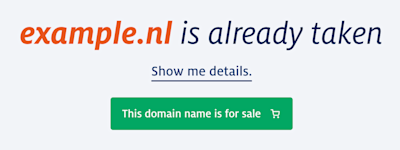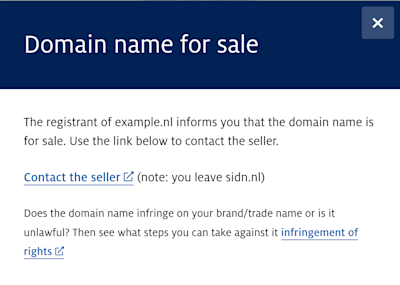A digital ‘For sale’ sign for .nl domain names
A proposed new IETF standard for the second-hand domain name market
Chose your color
Frequently visited
Frequently asked questions
The Whois is an easy-to-use tool for checking the availability of a .nl domain name. If the domain name is already taken, you can see who has registered it.
On the page looking up a domain name you will find more information about what a domain name is, how the Whois works and how the privacy of personal data is protected. Alternatively, you can go straight to look for a domain name via the Whois.
To get your domain name transferred, you need the token (unique ID number) for your domain name. Your existing registrar has the token and is obliged to give it to you within five days, if you ask for it. The procedure for changing your registrar is described on the page transferring your domain name.
To update the contact details associated with your domain name, you need to contact your registrar. Read more about updating contact details.
When a domain name is cancelled, we aren't told the reason, so we can't tell you. You'll need to ask your registrar. The advantage of quarantine is that, if a name's cancelled by mistake, you can always get it back.
One common reason is that the contract between you and your registrar says you've got to renew the registration every year. If you haven't set up automatic renewal and you don't renew manually, the registration will expire.
Wanneer je een klacht hebt over of een geschil met je registrar dan zijn er verschillende mogelijkheden om tot een oplossing te komen. Hierover lees je meer op pagina klacht over registrar. SIDN heeft geen formele klachtenprocedure voor het behandelen van een klacht over jouw registrar.
Would you like to be able to register domain names for customers or for your own organisation by dealing directly with SIDN? If so, you can become a .nl registrar. Read more about the conditions and how to apply for registrar status on the page becoming a registrar.
Domain names
Domain names
A proposed new IETF standard for the second-hand domain name market

The original blog post is in Dutch, this is the English translation.
In this blog, we describe draft-davids-forsalereg, known for short as ForSale. ForSale is an innovative, straightforward, low-threshold mechanism that allows a registrant to advertise the fact that their domain name is for sale – whether it’s a .nl or uses another extension. We’ve already implemented the proposed standard in a .nl pilot scheme, with several registrars now using ForSale to help their customers sell their domain names. We hope that ForSale will help to make the domain name market more transparent and accessible, so that domain names can be traded more quickly and effectively.
Suppose that you’ve got a nice car that you no longer want. Maybe it’s costing too much to keep on the road, or maybe you fancy upgrading to the latest model. What do you do? Most people will try to sell their car, perhaps using a platform such as Marktplaats or Autotrack, perhaps through their local dealer or a car trading company.
Now, imagine a situation where people don’t sell their used cars, even if they’re in really good condition. Instead, they simply take them to the scrapyard. And all the scrapyards are patrolled by dealers, who pick out the good cars and take them away to sell on their forecourts. The dealers don’t pay the previous owners anything; all it costs them to pick up a used car is a fee for getting the registration documents reassigned. A used car market that worked like that would leave most people open-mouthed. Yet that’s more or less how it works with many used domain names.
While most used cars are resold, many unwanted domain names are simply allowed to lapse. Meanwhile, specialist companies monitor all the registrations that come to an end, and snap up the good ones. They more or less retrieve domain names from digital scrapyards, get the registrations transferred to themselves and park the names on their digital forecourts with prices in the windows. And, when a name sells, the dealer pockets the money without giving the previous registrant a cut.
That practice is known as ‘drop catching’, and the specialist domain name traders are referred to as ‘domainers’. Their activities bring hundreds of thousands of used domain names to market. The names stand on the dealers’ digital forecourts, waiting to start new lives with new owners.
Now, you might think, “Great, that means lots of domain names to choose from.” After all, there are always plenty of people looking for good domain names. Until recently, however, there was a problem: often, it wasn’t immediately clear that a domain name was for sale.
Because, all too often, someone wanting a domain name starts by searching for it on a registrar’s website or SIDN’s Whois page, only to discover that their preferred name has already been registered by someone else. In the kind of situation described above, that someone is the domainer. Discovering that their preferred name is already taken, the would-be registrant starts looking for alternatives, unaware that their first choice was available all along, on one of those digital forecourts!
SIDN sees that as an undesirable situation, because of course we want everyone to be able to get their first-choice name. If that happens to be a name that’s already registered but isn’t currently in use, we think it should be easy to get the name transferred. That way, the domain name gets a second chance, instead of standing idle on a digital forecourt.
Clearly, the life cycle of a domain name is quite different from the life cycles of other used items. So, here at SIDN Labs, we wondered whether a better system might be possible. With the help of our registrars, we set about finding a low-threshold, acceptable way of achieving a better balance between supply and demand; a way that would in principle be universally applicable and ethically responsible, and that wouldn’t require further involvement by us in our registry role.
That led to the development of a so-called ‘internet draft’, proposing a mechanism that would allow the registrant of a .nl domain name (or a domain name with another extension) to offer their name for sale via the DNS. Known as ‘ForSale’, our mechanism for putting up a digital ‘For sale’ sign has been submitted to the Internet Engineering Task Force (IETF) for consideration. The draft’s full title is: The "for-sale" Underscored and Globally Scoped DNS Node Name.
The idea behind the draft is that the method should be universally applicable, not something that only works with .nl domain names. Since coming up with our mechanism, we’ve started a pilot on our own system in partnership with our registrars.
A registrant sticks a digital ‘For sale’ sign on their domain name in the form of a TXT record in the Domain Name System (DNS). That label is an indicator that (the right to use) the domain name is for sale, or available to lease.
After that, there are various possibilities. One is to include readable information in the TXT record, which anyone reader can easily interpret. For example “This domain name is for sale. For details contact…”. Another is to format the information in a smarter way, enabling automated systems to pick it up and process it.
At SIDN, we’re adding ForSale support for .nl domain names in collaboration with the .nl registrars. Our approach involves doing something fairly special with the ‘For sale’ sign, as explained below.
Registrars that want to be involved can enter the URL of a ‘landing page’ (‘For sale’ page for domain names) on our registration system. We then convert the URL into a unique code, which can be attached to each of the registrars’ domain names that’s for sale, in the form of a DNS record.
Let’s walk through the ForSale procedure one step at a time. We’ll use the domain name ‘example.nl’, whose registrant is looking to sell, and which is registered through a fictitious registrar called Domain Registration Ltd.
Step 1: Domain Registration Ltd provides SIDN with details of its landing page, https://domain.nl/forsale. Our system responds by providing a unique ID code for that URL:
NLFS-NGYyYjEyZWYtZTUzYi00ExAmPlEiNmYtNTcxZjBhMzA2NWQ
Step 2: The registrant of example.nl decides to sell the domain name through Domain Registration Ltd. That company’s control panel features a ‘Sell’ button that example.nl’s registrant can click to activate ForSale for the domain name. ‘Under the hood’, a ForSale TXT record is then generated and added to the DNS. The registrant doesn’t therefore have to worry about the technicalities of the system. Nevertheless, the registrar’s website should clearly explain what happens if you click the ‘Sell’ button.
Step 3: A digital ‘For sale’ sign is now attached to example.nl in the DNS. The sign takes the form of a ‘FORSALE’ label something like this:
_for-sale.example.nl. IN TXT “v=FORSALE1;fcod=NLFS-NGYyYjEyZWYtZTUzYi00ExAmPlEiNmYtNTcxZjBhMzA2NWQ”
You might recognise the last part of that as the landing page ID code. However, you don’t have to worry about that just now: it’s relevant only to SIDN’s automated system. A registrant is very unlikely to see or need to use the code.
What matters is that the ‘For sale’ sign is now up! Where appropriate, information that humans can understand can be added. For example:
_for-sale.example.nl. IN TXT “v=FORSALE1;fcod=NLFS-NGYyYjEyZWYtZTUzYi00ExAmPlEiNmYtNTcxZjBhMzA2NWQ” IN TXT “v=FORSALE1;ftxt”Domain name is for sale / Domeinnaam is te koop”
Suppose you want a domain name, and you come up with the idea of ‘example.nl’. You check its availability on SIDN’s domain information page and find that it’s already registered (taken). However, the current registrant has activated ForSale, so the domain name is labelled in the DNS as being for sale. Our system reads the label and the landing page ID code, and adds a green button reading “This domain name is for sale” to the information shown to you when you look up ‘example.nl’.

If you click the button, you’re redirected to Domain Registration Ltd’s landing page on sidn.nl:

The URL that you land on next is the landing page referred to earlier, which looks like this:
https://domein.nl/forsale?domein=example.nl
We can tell what contact URL we need to provide by referring to our database and looking up the code of the domain name you searched for (‘example.nl’). On Domain Registration Ltd’s ‘For sale’ page, we also identify the domain name that’s for sale using a ‘query component’. That brings SIDN’s involvement in the process to an end. From here, Domain Registration Ltd takes over, perhaps providing you, the potential buyer, with a way of bidding for the name, or with the means to contact the current registrant. Domain Registration Ltd is free to make its own commercial arrangements with the current registrant and you. For example, the firm might charge a commission on each sale. We don’t get involved in those arrangements at all
With ForSale, the recorded information doesn’t have to be a cryptic code like the one referred to above, which only SIDN can recognise. The TXT record can contain a URL, an e-mail address or phone number, for example. Or simply readable text, or the domain name’s asking price. Within the parameters of the draft, you can use ForSale any way you like. It can be used in combination with automated systems, or with manual processing in mind.
Third parties, such as domain name brokers, can use ForSale with their own variants of our cryptic codes, for instance.
For details of how that would work, see our IETF draft, which is likely to be of interest mainly to people of a technical bent.
We’ve developed ForSale with the aim of helping to make the domain name market more transparent and accessible, so that domain names can be traded more quickly, fairly and effectively.
We want to provide registrants with an easy way of selling their .nl domain names themselves. That would enable a registrant to get a fair price for their domain name, rather than simply dropping it and getting nothing. We also hope that the system will help to keep .nl accessible to everyone, rather than becoming the exclusive province of professionals such as domainers and drop-catchers who specialise in ‘catching’ dropped domain names. The trade in dropped domain names can nevertheless remain profitable, just as the used car trade is. It could even be that our system changes the dynamics of the used domain name market.
Whether that actually happens will depend partly on how widely ForSale is adopted. We have therefore opted for a universal approach via the IETF, with the aim of maximising the prospects of adoption.
Our landing page method is already ‘live’, in the form of a pilot, which registrars are invited to join. If you’re a registrant who likes the sound of ForSale, ask your registrar whether they support the new protocol.
Our landing page pilot has already been running for several years, but is based on an earlier version of the draft. The concept has been refined considerably since that version was developed, and the software for the latest version is now ready to go ‘live’. However, we’re holding it back until it’s clear that no further modifications are in the pipeline. Once we’re confident on that score, we’ll work with our registrars to implement the finalised version. This blog describes the most recent insights from version 11 of the draft, which is not the version used for the pilot.
Article by:

Share this article